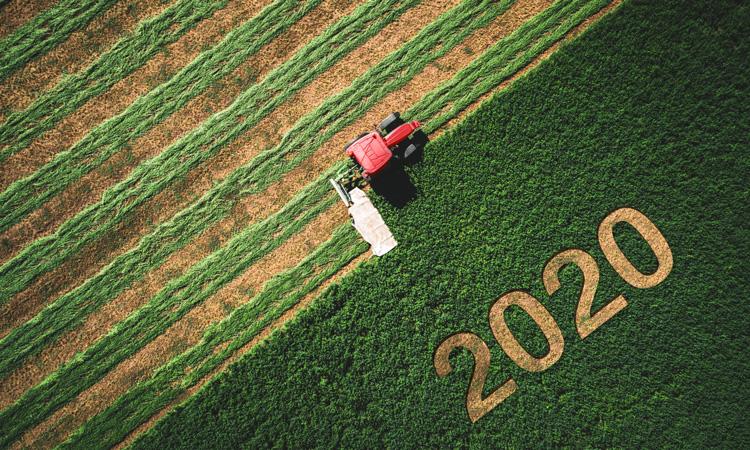TAG revises its 2020 food industry predictions in light of COVID-19
- Like
- Digg
- Del
- Tumblr
- VKontakte
- Buffer
- Love This
- Odnoklassniki
- Meneame
- Blogger
- Amazon
- Yahoo Mail
- Gmail
- AOL
- Newsvine
- HackerNews
- Evernote
- MySpace
- Mail.ru
- Viadeo
- Line
- Comments
- Yummly
- SMS
- Viber
- Telegram
- Subscribe
- Skype
- Facebook Messenger
- Kakao
- LiveJournal
- Yammer
- Edgar
- Fintel
- Mix
- Instapaper
- Copy Link
Posted: 11 May 2020 | Dr David Acheson | No comments yet
Dr David Acheson, MD, President and CEO of TAG, offers revisions to his January predictions and suggests which paths the US and global food industries might follow in 2020 and beyond.


In January 2020, The Acheson Group (TAG) made its food industry predictions for the coming year, based on the insights of its team of food safety and public health experts. Now, in light of COVID-19, we have revised this forecast.
In our earlier predictions, we discussed areas as diverse as the continuation of romaine outbreaks, traceability, food safety culture, global standards, FSMA, innovation, and labelling. What we could not predict was the COVID-19 pandemic and all that went along with it.
So, given the pandemic, what has changed? What do we expect for the remainder of 2020?
In relation to our predictions, the greatest change caused by the pandemic has been the relegation of many of the food industry initiatives to the back seat, with worker protection taking over the driver’s seat and business continuity efforts riding shotgun. The pandemic has impacted every aspect of the food industry; and, because it is considered to be a critical infrastructure, the industry has had to deal with those impacts and implement employee protection initiatives while continuing to produce safe, quality food.
Given that, we can update our predictions, grouping the 10 into five categories:
1. Food safety


In 2019, FDA introduced its New Era of Smarter Food Safety, two of the key components of which were Food Safety Culture (our #3 prediction) and Traceability (#2), which included a key focus on produce, because of the increase in Romaine E. coli Outbreaks (#1).
With both traceability and food safety culture being complex areas, for which no industry-wide standards had yet been set, we had hoped, and expected, that this New Era blueprint would provide some direction in both areas to help the industry begin to move down the road to implementation. As discussed in an April 2020 FDA Q&A with Deputy Commissioner for Food Policy and Response Frank Yiannas, the agency had planned to publish the blueprint in March but had to shift its efforts to pandemic response. But, the pandemic also has provided FDA with some new realisations that will be considered in the blueprint.
For example, in relation to food safety culture, Yiannas said: “It’s clear to me that a food safety culture is also one that protects the employees from risks associated with workers who are sick, regardless of the type of virus or bacteria, and supports the maintenance of clean and sanitised facilities.” And that health and safety will be even more important in the “new normal” that follows the pandemic.
2. Standards and regulation
Rather than standards and regulations becoming more tightly focused, as we had predicted in January, FDA has loosened – in fact, had temporarily discontinued – FSMA-targeted international facility inspections (#7); and enforcement of the FSMA IA Rule which was slated for March has not even been mentioned. At the same time, however, we are seeing indications that intentional adulteration and food fraud (#10) are areas requiring particular attention due to pandemic-caused disruptions in supply chains around the world.
As food manufacturers seek to quickly replace supply lines from areas, ingredient, or businesses hard hit by the pandemic, they must also be ensuring to conduct risk assessments on new or temporary suppliers to ensure they maintain the standards of food safety and quality and are not taken in by the good price or false promise of an economically motivated adulterated product.
In relation to standards, we had predicted proactive messaging from GFSI about its value – due to some industry questioning of this. But, in actuality, we’re also seeing a pullback on GFSI standards (#5), particularly those of plant audits, due to the travel and visitor restrictions of the pandemic. We would expect both to revert to “normal” once restrictions are lifted, but exactly when that will be with the phased-in recovery that is recommended is unknown, as is how quickly both FDA inspectors and GFSI auditors will be able to get to the backlog – both domestic and international – that has been piling up over the months of the pandemic.
3. CBD, THC and other cannabinoids
In our predictions, we had said, “While FDA is working to create a regulatory framework at the federal level (for cannabinoids in food and as a dietary supplement), there is limited scientific information available, and it will likely take some time.” Our overall predictions have not drastically changed, although we have seen some additional enforcement from FDA on CBD products claiming to cure or prevent COVID-19, which fits into the same enforcement category as we had expected from the FDA, just directed at the new disease.


So, we would expect that there will be a contraction of the industry for the rest of the year due to COVID-19 limitations of retails sales and other reasons. The long-term prospects are much brighter… once retail restrictions are lifted. Edibles sales are going well, especially for chocolate, and we expect these to expand faster than traditional cannabis products in the next year. So far, there have been no publicised food safety issues associated with legal edibles in Canada.
4. Innovation
Two of the areas on which we focused in our predictions were those of home delivery of restaurant meals and in-store and home-delivered meal kits. With the COVID-19 closure of in-restaurant dining across the US, this has been accelerated to an extent we could never have expected. It also is another area on which Yiannas focused, noting that part of the New Era work involves dealing with the reality of e-commerce home-delivery of foods and how to ensure the safety of production, packaging and transporting of those foods. When FDA began the discussion, it expected a 20 percent increase in grocery delivering by 2023, but Yiannas said, “That benchmark may have been blown out of the water by consumers sheltering in place.” And we, like Yiannas, do not expect that trend to reverse in the “new normal.”
5. Labelling


Nutrition Labeling (#6) and BE Labeling (#9) were key areas in which we expected to see continued evolution and regulation. With an implementation date of 1 January 2020, we expected the National Bioengineered (BE) Food Disclosure Standard to gain attention through the year. But, with the dual factors of the labelling not being mandatory until 2022, and the industry disruptions caused by COVID-19, we don’t expect as much, if any, public interest to be generated, at least until after we have phased into some sort of post-pandemic life.
Similarly, although FDA was expected to begin rolling out and enforcing new nutrition label standards, March and April saw a number of FDA announcements on “temporary flexibility” in labelling requirements and the extension of comment periods on food standards modernisation. Again, we would expect this to pick back up, but there will likely be a lot of other initiatives that take precedence.
At the end of our original 2020 predictions, we stated, “The world of food safety continues to get more complex and challenging.” We had no idea at that time just how complex and challenging it would become a short couple months later. But no matter how many complexities and challenges arise to distract our focus, food safety must always remain a priority. And we are seeing the vast majority of the industry working hard to rise to that challenge to continue to produce safe, quality food while protecting their employees. We predict that that will have a positive impact over the long-term.
About the author
Led by former FDA Associate Commissioner for Foods Dr. David Acheson, TAG is a food safety and public health consulting group that provides guidance and expertise worldwide for companies throughout the food supply chain. With the advent of the COVID-19 pandemic, TAG’s public health and infectious disease expertise has been brought to the forefront to assist food businesses weather the increased challenges of employee protection, food safety, and business continuity. With in-depth industry knowledge combined with real-world experience, TAG’s team of experts helps companies assess their unique situation, address gaps, and deploy best practices to more effectively mitigate risks, improve operational efficiencies, and protect their brand.
Related topics
CBD hemp & cannabis, COVID-19, Food Fraud, Food Safety, Hygiene, New product development (NPD), Regulation & Legislation, Research & development, Supply chain, Technology & Innovation









